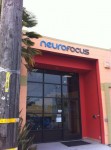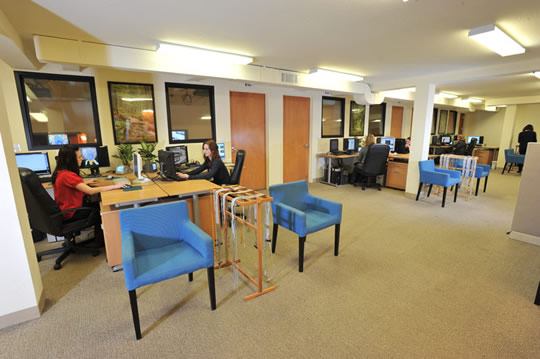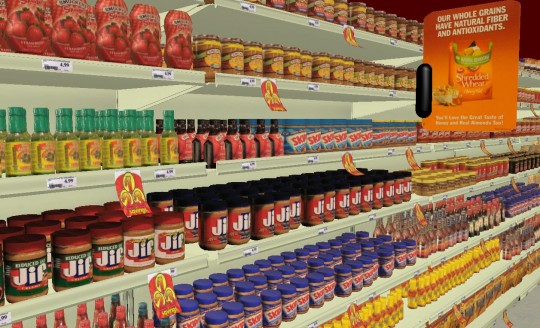Inside NeuroFocus
 Somehow, one might expect the most prominent neuromarketing firm to have more ostentatious offices than a modest two-story building nestled in a mixed-use Berkeley, CA neighborhood. A skateboard park is across the street, and neighboring businesses include discount outlets and small industrial firms. Much like our skulls, though, the exterior of the Neurofocus HQ conceals a beehive of complex activity.
Somehow, one might expect the most prominent neuromarketing firm to have more ostentatious offices than a modest two-story building nestled in a mixed-use Berkeley, CA neighborhood. A skateboard park is across the street, and neighboring businesses include discount outlets and small industrial firms. Much like our skulls, though, the exterior of the Neurofocus HQ conceals a beehive of complex activity.
First, here’s a video from ABC News. They visited a day or two after I did, and their production values are a lot better than mine:
NeuroFocus EEG Lab
My own visit had a few highlights. First, the EEG lab at NeuroFocus has six complete monitoring stations and is thought to be the world’s biggest. Test subjects were coming and going continuously, though I didn’t get to see an actual study underway. This is what it looked like:

Virtual Shopping Experience
While much of the attention given to neuromarketing studies is focused on ads, product packaging can be equally, if not more, important. NeuroFocus aims to help marketers find out why people select products from a store shelf crowded with competing products, and how to improve packaging to maximize sales. The last virtual reality experience I had was a couple of decades ago, and involved putting on a helmet that delivered chunky, simplistic graphics to each eye and allowed one to stumble about a tiny room. The system I saw at NeuroFocus was clearly a few generations past that.
While I wasn’t able to interact with the 3D environment, the recorded simulation I saw was impressive. Only lightweight 3D glasses were required, and a big screen in front of the viewer showed a nearly photorealistic store environment. The shelves were filled with products, and the use of sophisticated 3D modeling algorithms added reflections and shadows to the products. This made the shelf display quite realistic, and it’s easy to imagine engaging with the environment much as one might an immersive video game. A shopping cart will sense the subjects movements, and ultimately the subject will be able to “touch” the products on the shelf. What I saw was, in essence, a movie; if NeuroFocus can deliver a high level of interactivity with the 3D environment, they will have a quick way of simulating, say, a WalMart aisle filled with soft drink products; multiple package variations for a new product could be placed in this environment to see how consumers reacted. Doing this virtually would presumably be significantly faster and cheaper than actually creating the physical packages and attempting to evaluate them in an actual store environment. (See also Virtual Supermarket.)
Neurofocus is clearly intent on pushing forward in the field of neuromarketing. They have been aggressive in courting mainstream press attention, as the latest ABC coverage shows, and at the same time have been adding high-profile scientists to their advisory board (see Star Power for NeuroFocus: Nobelist Eric Kandel.) While declining to participate in the Advertising Research Foundation (ARF) neuromarketing standards development process, they say they will increase the transparency of their own science. Dr. A. K. Pradeep’s 2010 book, The Buying Brain, inched in that direction.
My visit to NeuroFocus coincided with the initial public offering of their biggest investor, Nielsen. (See “Neuromarketing IPO” a Success.) Here’s an interview that offers my take on that IPO and the neuromarketing industry:



Hello Roger,
Thank you for this post, it’s really interesting!
Do you think that a 3D environment is good enough to reproduce the context of buying decisions? Does this kind of 3D environment produces sounds or is it only about the sight?
Because it was often shown in studies that all the senses have an impact on our decisions making processes.
Another thing I was wondering while reading this post is : isn’t the subject influenced by the fact he knows his reactions will be observed? Do you know if studies were made about that topic to make sure that it doesn’t affect the results?
Regards,
Gabriella
Gabriella, I’m sure the best scenario would be observing the behavior of real shoppers in real stores spending real money while doing their real shopping. Trying to evaluate eight different packaging variations (for example) in the real world is an expensive proposition. One would hope that a good virtual simulation would point in the right direction and allow choices to be made for rolling out in test markets.
Roger